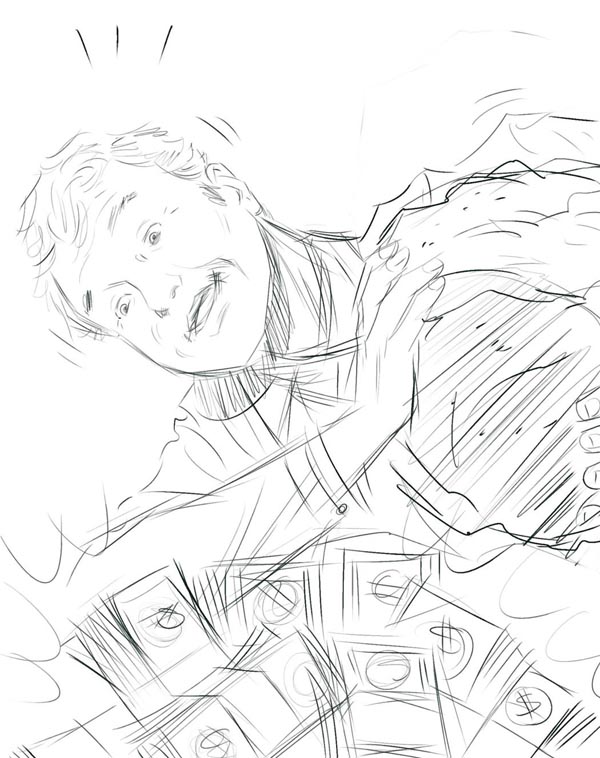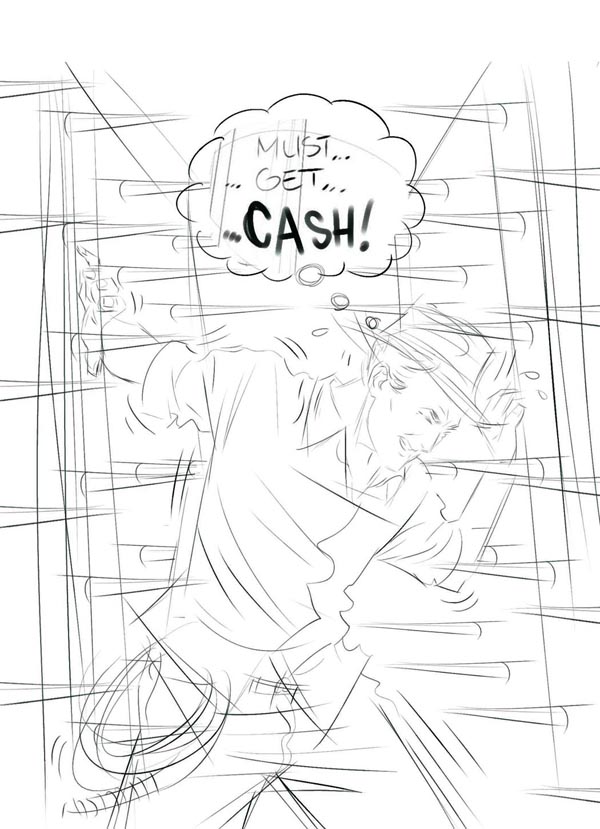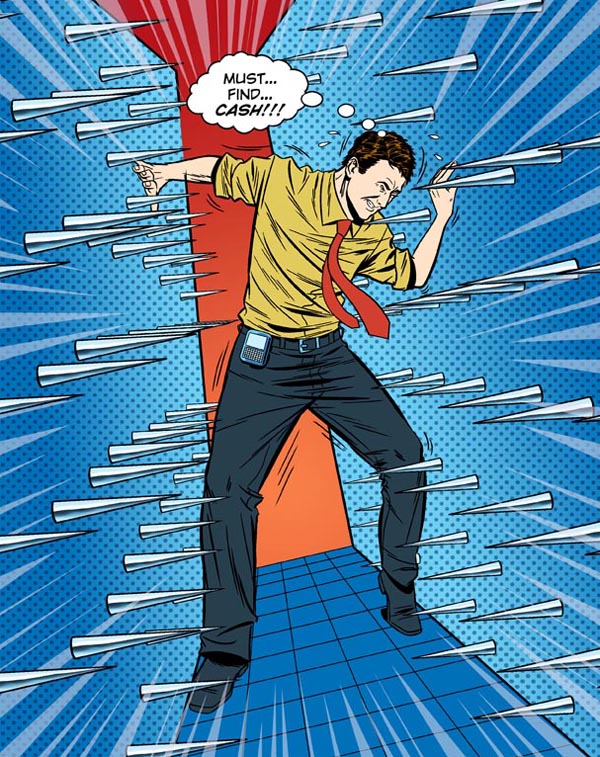Whether you specialize in advertising, film, animation or comics, whether you do finished illustration, graphic design or concept art (or some combination of those specialties) you've probably noticed;
Business sucks.
As an artist, educator and blogger I've developed friendships and affiliations with a lot of people all over the world in a huge variety of graphic arts industries. And from all over I've been hearing the same desperation-tinged question: "Where has all the work gone?"
We've been going through the worst economic downturn since the Great Depression so naturally one would expect business to be slow. For those of us who went through the '93 Recession ( and later, smaller downturns ), we know from experience what this feels like. You hunker down and stay hopeful and eventually things turn around.
Last week I sent an email to a long-time friend who does boards in Toronto asking how things were going. He wrote back, "What can I say? The ad biz is not like it used to be, that's for sure. Not a business I would recommend to anyone right now. You did well to get out when you did. It might turn around but it's hard to say when."
The question is, are things going to turn around this time?
If this article at fastcompany.com is correct then I think the answer is "no."
In her article, author Danielle Sacks describes the ad biz many of us have comfortably participated in for all the years of our careers:
"The ad business became an assembly line as predictable as Henry Ford's. The client (whose goal was to get the word out about a product) paid an agency's account executive (whose job was to lure the client and then keep him happy), who briefed the brand planner (whose research uncovered the big consumer insight), who briefed the media planner (who decided which channel -- radio, print, outdoor, direct mail, or TV -- to advertise in). Then the copywriter/art director team would pass on its work (a big idea typically represented by storyboards for a 30-second TV commercial) to the producer (who worked with a director and editors to film and edit the commercial). Thanks to the media buyer (whose job was to wine-and-dine media companies to lower the price of TV spots, print pages, or radio slots), the ad would get funneled, like relatively fresh sausage, into some combination of those five mass media, which were anything but equal. TV ruled the world. After all, it not only reached a mass audience but was also the most expensive medium -- and the more the client spent, the more money the ad agency made."
Then Sacks described how dramatically things have changed:
"That was then. Over the past few years, because of a combination of Internet disintermediation, recession, and corporate blindness, the assembly line has been obliterated -- economically, organizationally, and culturally. In the ad business, the relatively good life of 2007 is as remote as the whiskey highs of 1962."
Sacks continues, "The death of mass marketing means the end of lazy marketing. At agencies, the new norm is doing exponentially complex work. Think of the 200 Old Spice YouTube videos whipped up by Wieden+Kennedy in 48 hours. "Creating more work for less money is the big paradox," says Matt Howell, president of the Boston agency Modernista."
And further (and perhaps most importantly for us), "Squeezed by clients, agencies are also beset by a host of new competitors attacking from every direction. Technology companies have commoditized much of the "art" of that old assembly line. Producing an ad doesn't have to be an expensive multiperson affair these days, given that commercial-quality high-definition video can now be shot on cameras that cost less than $2,000."
If you're a storyboard artist, look at the new face of the ad industry as described in Sacks' article and ask yourself if the $100 - $200 per frame you're used to getting for your work fits this 21st century ad budget:
"GeniusRocket is what an ad agency looks like when it's stripped of Madison Avenue skyscrapers, high-priced creatives on payroll, sushi dinners at Nobu, and two-week shoots at the Viceroy in Santa Monica. The firm is nothing more than a bare-bones website that crowdsources broadcast-ready TV ads from a pool of loosely vetted talent from Poland to Guam. A CMO accustomed to handing over millions of dollars to an agency for a campaign designed around a single spot can now hand GeniusRocket $40,000 -- and get seven spots, each of which will be syndicated on 20 web platforms for tracking, testing, sentiment analysis, and wide distribution."
Sacks quotes Aaron Reitkopf, North American CEO of digital agency Profero, and writes, "There's only one thing everyone agrees on, and that's that there is too much excess: too many people, too many of the wrong kinds of people, too much bloat, too much inefficiency. And this in an industry that has laid off more than 160,000 people in the past two years. "Ohhhh," nods Reitkopf, "the carnage is going to be awesome."
One thing I'm sure of is that that as dire as things seem to be, creatives like us are now and will always be relevant. There is and will always be opportunity for those who are talented and determined and most importantly flexible and innovative. I think communities like ours are a valuable asset to all who participate in them - in any capacity.
I've got a lot more to say on this subject but I'm curious to hear from you, the members and readers of Storyboard Central. What has your experience been over the last couple of years? How are you dealing with the downturn in the market? I hope you'll comment. Share your thoughts, advice and experience with us! :^)
* I encourage you to read Danielle Sacks' entire article, The Future of Advertising at fastcompany.com
* The images used in this post are my rough concept sketches and finished art for a 2009 article in Profit magazine.




I used to reinvent myself through the years as the business changed, and it's always changing. I began as a graphic designer in Detroit art studios, but soon found illustration to be more lucrative. When automotive related art started going photographic I hooked up with a sharp New York rep who kept me quite busy, also had a rep in Chicago. For years I specialized in ink line art. I even became a partner in a studio before becoming an art director at Campbell Ewald in Detroit. Then came my freelance period before leaving for Paris, France where I did illustrations and many storyboards for several years. Next came ten years in New York City, mostly doing storyboards as the illustration field was drying up. In 1993 I moved back to a small town in Michigan, but still had reps in New York and Chicago, I even managed to get work out of LA, SF, Boston and Detroit. I finally decided to quit the business as the deadlines on storyboards were getting brutal, the last year that I worked, every job had an overnight deadline. I had a fun career that began when I was 15 and went right through to age 78, that's 63 years in the ad biz. I actually still do a few graphic design jobs and once in a while an illustration.
ReplyDeleteI've been fairly steady, but having said that, it is a different market than it was in the '80's & '90's, and it's not just the recent recession. There is not the volume of work (remember the huge pitches?) but I also don't handle the same volume of work I used to, with it's all-nighters and wrecked weekends. It's not just that I'm older and don't have the energy, I now have a family with young kids and although I far from the perfect parent, I find that they now have priority over everything - whether I like it or not. :)
ReplyDeleteI had a short conversation with AdBase the other day about their limited data resources for illustrators for industries outside of the traditional print & TV medium ie- game & movie companies. Their response was that anybody they contact say they don't hire freelance illustration, which I found odd.
Harry, you are absolutely the best example of what I mean by "flexible and innovative." Your career is a testament to how versatility and optimism can lead to success, no matter what happens. For those of you who have never visited Harry's blog, do yourself a favour and spend a good long time there perusing Harry's work - and his words. As he says, he survived constant change and spent 63 years in the business - and continues to experiment and make new art every day! My hero!
ReplyDeleteGo to http://harryborgmanart.blogspot.com/
Mark; you're right on. Remember how much of our work used to be print ad comps? Then, while I was 'away' for a decade doing finished art, the work became predominantly storyboard frames and animatics. Now, if major clients like Kraft are dumping their agencies and going with these boutique operations that can crank out 20 ads for youtube over a weekend, I think we must prepare ourselves for another major shift.
ReplyDeleteRegarding the video game and movie industry, I think there will actually be an increase in demand for concept artists in the years ahead -- but the dynamic will be very different.
It would be great if those currently working in those markets gave us the benefit of their experience and predictions. :^)
(Ok, I'll try this again. Somehow my post died on arrival.)
ReplyDeleteI confess I didn't read the article, but how does an agency pump out a bunch of YouTube ads overnight? I've found that clients have become much more detail obsessed over the years and can't imagine they'd let the creatives off the leash without at least approving a script, let alone taking frames or an animatic to testing.
Sounds like 'musical chairs' of another dying industry. Is advertising streamlining it's resources by taking advantage of the digital revolution? It's probably necessary, since it has become increasingly difficult to justify everyone's hand in the client's pocket. Are storyboards and other preliminary visuals included in these unnecessary expenditures? This is where I'm confused. I understand how the digital medium can "crowdsource" to create a ton of ready to air spots and ads, but to suggest the only medium left to to place this digital neo-advertising is the internet? C'mon!! Believe it or not, my inspiration for a continued career in boards is radio. Video couldn't kill the radio star (neither could XM Satellite and the like). Therefore, I can't see the traditional television media drowning in the wake of the monster internet. Here's how I see it breaking down: Broadcast media is free to the public (which is why you don't have to buy tickets to see a taping of say, Letterman). Good entertainment on this medium costs money, lots of it! Advertisers pay these entertainers in exchange to place their products in commercials which will be exposed to the public enjoying the program of interest. From what limited understanding I have of Ms. Sacks' article is that ALL traditional media is going the way of the dinosaur due entirely to the internet. I'm sorry, but there's nothing to watch on the damn thing! Not for me anyway and I'm 45; on the cusp between boomers and Xgens. I don't want to interact, add my input to a commercial or look at mindless YouTube videos. I just want to sit on my ass and be entertained. Also, she's telling us that a place like GeniusRocket only needs $40,000 to produce 7 finished spots? Sounds like sight unseen to me as I can't imagine any product brand manager not wanting to see preliminaries before signing off on 7 concepts, no matter how cheap they're made. And that's why storyboard artists will always be in demand. So, have faith my friends; though it's been slow, the sky isn't falling...YET!
ReplyDeleteAs a point of interest, print publishing might also be on death's door, but I much prefer a newspaper or magazine whilst on the shitter, as opposed to an iPad or laptop...they just feel too cold sitting on my lap! That's my 2 (long) cents!
I really like your sketches and finished illustration for this post Leif .After 16 years of drawing in Photoshop I've come to really appreciate the humble pencil sketch .(Even when it's done in Painter:)
ReplyDeleteVery interesting (and scary) article.
Mark; The youtube scenario is referring to that Old Spice campaign. You may have read that they put the actor in front of a webcam one weekend and had a team of five copywriters standing by. as questions streamed in from viewers the writers came up with funny answers and typed them onto a teleprompter so it would seem like the actor was ad-libbing them. It was wildly successful and I guess they just used a bunch of that material edited together and Voilà - instant commercials. (That's just my guess, though)
ReplyDeleteThe detail obsessed thing is, I think, self-serving agency ass-covering and is probably a desperate visceral reaction to what this article describes as happening: clients slipping through the agencies' fingers like sand.
Glenn; I'm not surprised by your reaction - its exactly how I/ we all feel, but you gotta remember, we are exactly what you define us as: the boomer/gen x straddlers. In other words, dinosaurs. ;^)
ReplyDeleteMy kid is 16, reads a TON every day - none of it on paper. He watches hours of tv every day - commercial free on Netflix and Youtube. When he has to endure me in the room watching 'actual' tv - that is, with commercials - he grabs the remote and mutes the sound at every commercial break. Tradititional tv commercial marketing isn't reaching him. He IS the future. Advertisers have realized this.
You have, relatively speaking, almost no disposable income. Your money's tied up in taxes, mortgage, utility bills, etc. What's left to spend on the goods and services advertisers want you to buy is a fraction of the total money you make.
My son has to put half his money away for college... but the other half is his to spend as he pleases. He has 50% disposable income. Even though that's only a few grand a year from his part-time job, his buying power is awesome. And study after study shows that this generation of parents listens to their kids when making decisions about major household purchases. KIDS decide what kind of car the family will buy.
Add all that up and you can see that while print advertising probably will never completely go away, and television advertising probably also won't, the growing percentage of any advertisers budget is going to be repurposed toward the next generations' media of choice. We need to be ready for that if we want to remain relevant.
Greg; thank you! I love the energy of a pencil sketch, too - often more than the finished illustration. I always get a kick out of seeing process stuff - this seemed like a nice opportunity to share something that showed how the concept for this piece was developed and revised. Yes, it is a scary article. I think it needs to be taken seriously and I hope this will be a starting point for some dialogue on the subject. Harry Borgman's first sentence says it all: "I used to reinvent myself through the years as the business changed, and it's always changing."
ReplyDeleteI think adapting to this new era is of the essence. Perhaps there won't be a lot of TV ads in the future, but I don't they'll dissapear, as they still have an impact on viewers. And even if they end up in Youtube, there's still gonna be a need for details and crafted ads, at least for that platform (you don't have to buy that time and there's an HD option).And there's films, video games, web animations, all of those require talented people.
ReplyDeleteMaybe part of my thoughts are wishful thinking, but I believe that no matter how much things change in an industry, talent and professionalism always stand.
Right on, Esteban - your positive outlook will help you to adapt to change. As Harry Borgman commented, change is inevitable in this business - and he would know - he's been in it since 1947! :^) I'm planning on writing a follow-up post to this one. I hope others will share their stories of adaptation and innovation so we can all benefit from the examples of those who are transitioning - or have transitioned - to adapting to the new market conditions.
ReplyDeleteIt is tough out there. I agree, stay flexible, keep your skills up to date and stay connected to your buds in the different areas of illustration. After years of advertising I stumbled into theme park concept art that has worked out well, but this industry has pretty dramatic peaks and valleys too.I try to keep up my "freelance attitude" and try to watch the trends, looking for areas where I could market myself doing the quick type of sketch art that I've worked so long at.
ReplyDelete